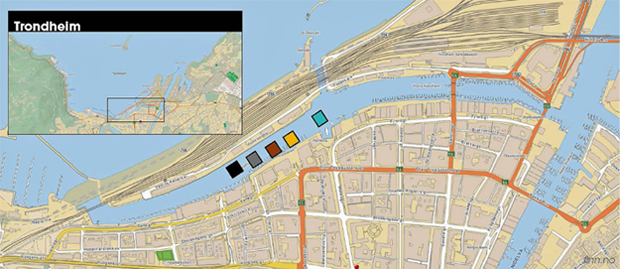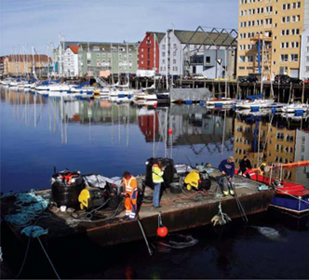|
Engineering Specifications and Contracting
Detailed engineering design, specifications, and construction contracts were not available for inclusion with this case study. The conceptual design and placement methods for the project are in the NGI Final Report. The material below, is taken from that report.
The size of the experimental fields was ~200 m2 (slightly smaller than 15 x 15 m). The amount of AC was 5 kg AC per m2. Five experimental field plots were established: (1) a reference site with no capping, (2) a plot capped with AC only, (3) a plot with AC mixed with bentonite clay, (4) a plot with AC and then covered by a thin-layer (5 mm) of sand, and (5) a plot with a thin-layer of sand (5 mm) as a control.
The inclusion of the AC + bentonite clay was a unique approach that was intended to
i) create a viscous slurry to facilitate placement,
ii) to maintain the AC in place, (i.e. protect it from lateral advection and increase the longevity
of the capping treatment (tidal current up to 20 cm s-1) and
iii) to provide a more natural and viable substrate to the benthic fauna.
The purpose of the sand capping over the AC was also to protect the AC from erosion.
Placement Methods
To facilitate placement and AC particle settling, the AC was mixed with a 10% w/w NaCl solution in a cement blender (AC:water 1:3 v/v; 10 min) on a pontoon in the harbor (Cornelissen et al 2011). The purpose of the salt was to saturate the AC pore system with water that was slightly heavier than surrounding water. For the AC-only and AC+sand fields, this slurry was pumped out with a flexible manually operated hose (inner diameter 5 cm) that was moved evenly above the area of the seafloor to be covered by the particular amount of AC in the blender. The slurry was released approximately one meter above the sediment bed at a rate of 20 L/min. For the AC+clay plots, AC and bentonite clay (dry powdered white sodium montmorillonite clay, mean particle size 3 μm; pH 8.5; density 2.6 kg/m3) were mixed 1:1:6 with 10%-NaCl solution and pumped out as described above. For the AC+sand fields, a 5-mm thick sand cap (particle size 0-1 mm construction sand) was placed on top of the AC cap, 24 h after placing the AC, by spraying the dry sand under the water surface using sand blasting equipment.

The field experiment was carried out in a channel in the outer part of the Trondheim harbour, Norway.
Field size: 15 x 15 m. At least 100 m from the amended fields to the reference flield (blue). Black: AC only;
Grey: AC + clay; Dark brown: AC + sand: Yellow: Sand-only.
Performance Monitoring
Activated Carbon Placement and Retention
Placement effectiveness was evaluated using an underwater Remotely Operated Vehicle equipped with a video camera at day 1, and again at 5 months post-placement. The ROV photos are best viewed in the NGI Final Report. Summary findings reported for the field trials are below.
AC-only: the AC was clearly visible on the seafloor on day 1 as a black 5 mm layer on top of the sediment covering most of the field except a few small patches of bare sediment. After 5 months the sediment surface was not black anymore, but of more natural gray-brownish color. A vertical section of the sediment revealed that the AC layer was still in place forming an approximately 5 mm black layer covered with a few mm of newly sedimented clay.
AC+clay: the AC+clay suspension was spread patchily on the sediment surface on day 1. Five months later, however, the ROV images revealed a more homogeneous and smooth sediment surface. The NGI report suggest that bioturbation activity of the macrofauna resulted in the mixing of the material with the underlying sediment as the field looked similar to the reference site. The ROV observations also revealed the presence of epibenthic macrofaunal species.
AC+sand: Video recordings during sand placement showed that the covering of AC by sand was successful. The AC remained on the sediment surface while the sand was deposited on top of it. The sand formed a 0.5 - 1 cm surface layer protecting
the AC from resuspension and erosion. Five months later the sand was still on the sediment and no AC was visible at the surface. Vertical sections showed that the AC was still in place forming a ca 5 mm dark layer under the sand mm dark layer under the sand.
Cores samples were collected 12-months post-placement. AC, which was initially applied as a 2-5 mm thick surface layer, was reported down to a depth of around 3-4 cm. The investigators attributed the mixing to bioturbation by the benthic macrofauna as this is the normal bioturbation depth in the marine coastal systems of Norway.
AC was also measured in the top 3 cm in the collected cores. Measured amounts of recovered AC relative to the target AC addition, were approximately 32% of the placed AC was found in the cores for both the AC-only and AC+sand treatment plots, and approximately 60% for AC + clay. The investigators attribute the losses principally to the small size of the fields (15 x 15 m) in relation to the falling depth of the slurries (1-2 m). They further suggest that the AC-clay slurry had greater overall AC retention due to viscosity of the 1:1 v/v AC-clay slurry, and suggest that dosing AC mixed with a clay slurry is better than dosing AC alone.

Post-Treatment Monitoring
Post-application monitoring included flux of PAHs from the sediment into the water column, in situ porewater PAH concentrations, and uptake of PAHs into benthic organisms. One year after capping, intact sediment cores were collected from the amended plots for ex situ surveys of the capping efficiency in reducing the PAH and PCB aqueous concentrations and bioaccumulation by the polychaete Hediste diversicolor and the clam Abra nitida (Samuelsson et al 2015). Reduced pore water concentrations were observed in all AC treatments. Generally treatment efficacy was AC + clay > AC-only > AC + sand. The AC + clay treatment reduced bioaccumulation of PAH and PCB congeners between 40% and 87% in the worms and between 67% and 97% in the clams. Sediment capped with AC-only also led to reduced bioaccumulation of PCBs, while AC + sand showed no reduction in bioaccumulation.
The benthic macrofauna composition and biodiversity were affected by the AC in all treatment plots. The AC + clay had a lower impact on the benthic taxa than AC-only or AC + sand.
Study Conclusion
The AC + clay mixture was recommended as the optimal choice of the currently tested thin-layer capping methods for PAHs. AC + clay gave the highest AC recoveries (60% vs 30% for AC-only and AC + sand), the strongest reductions in sediment-to-water PAH fluxes and porewater concentrations, and the lowest impact to benthic recolonization.
Costs
The costs presented from these studies indicated that the AC itself was about $10/m2, with the placement costs in the same order of magnitude (Cornelissen et al 2011).
|





